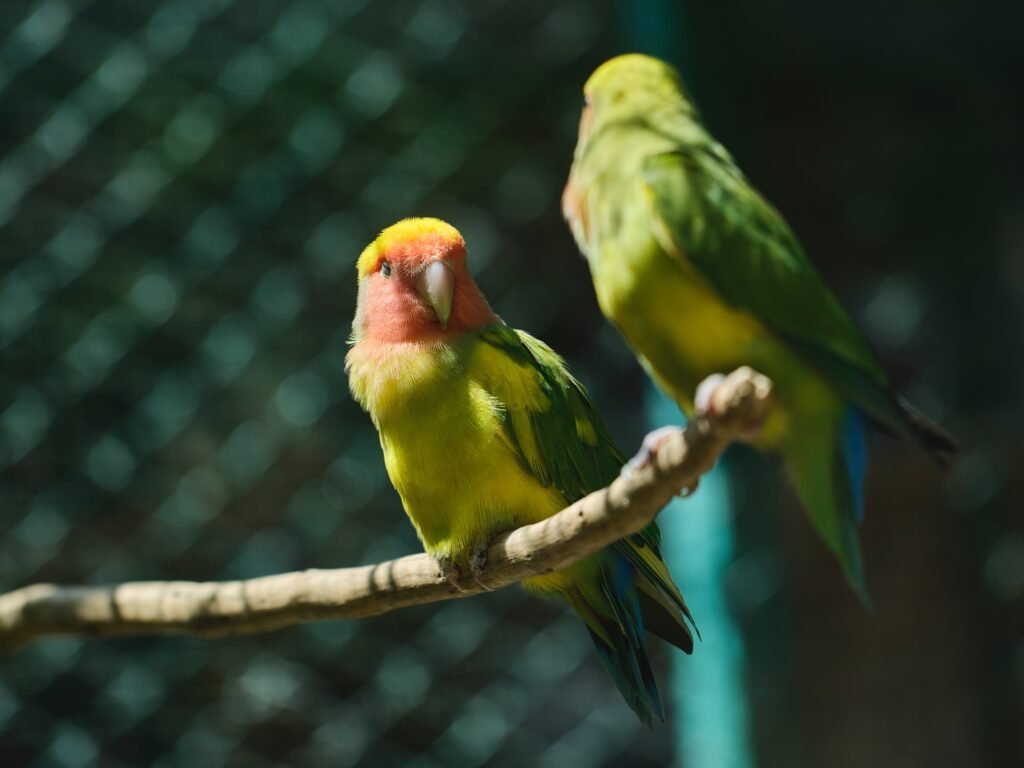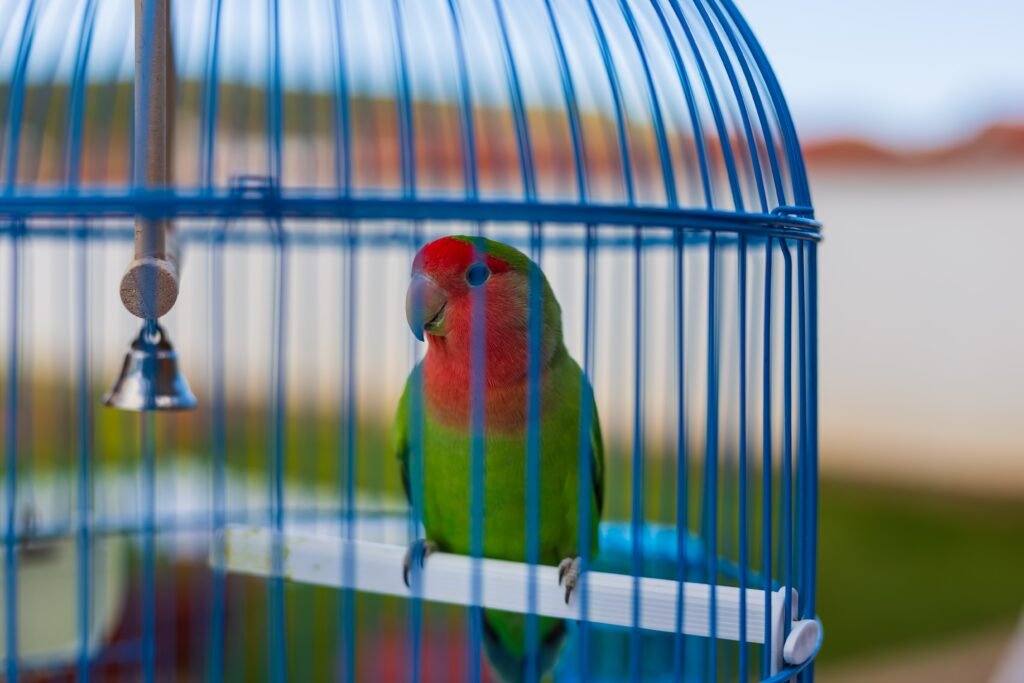Lovebirds are beautiful and social birds that make great pets. They are known for their vibrant colors, playful behavior, and strong bond with their mate. If you’re considering adding a lovebird to your avian family, you might be wondering what other bird species can coexist harmoniously with them. In this article, we will explore various birds that can live with lovebirds and provide insights into their compatibility.
Factors to Consider
Before introducing any new bird to your lovebird’s environment, it’s crucial to consider certain factors to ensure a successful and peaceful cohabitation. These factors include:
- Size Compatibility: Birds of similar sizes generally have better chances of getting along. It’s essential to consider the size of your lovebird and the potential bird you want to introduce. This is important to prevent any potential dominance or aggression issues due to a significant size difference.
- Temperament: Birds with similar temperaments are more likely to form positive relationships. Observe your lovebird’s personality and find a bird that complements their disposition. For example, if your lovebird is playful and active, consider a companion bird with a similar energetic nature. On the other hand, if your lovebird is more calm and relaxed, choose a bird that shares a similar temperament to avoid any conflicts.
- Social Needs: Lovebirds are highly social creatures, so it’s important to choose a companion that can meet their social needs. Some birds prefer solitude, while others thrive in flocks. It’s crucial to select a bird species that enjoys the company of others and is willing to interact and engage with your lovebird. This will prevent your lovebird from feeling lonely or isolated.
- Space Requirements: Make sure you have sufficient space to accommodate multiple birds. Providing separate cages or a large enough aviary is crucial for their well-being. Birds need space to stretch their wings, explore their environment, and establish their territories. Having enough space ensures that each bird has their own area to retreat to and reduces the chances of territorial disputes.
Compatible Bird Species for Lovebirds
Here are some bird species that can live harmoniously with lovebirds:
1. Budgerigar (Budgie or Parakeet)
Budgerigars, commonly known as budgies or parakeets, are one of the best companions for lovebirds. They have similar sizes, playful personalities, and are highly social birds. Budgies can provide excellent company to your lovebird and engage in interactive play sessions. They can chirp, mimic sounds, and even learn simple tricks, which can keep your lovebird entertained and mentally stimulated. Additionally, their vibrant colors and ability to bond with other birds make them a great choice for cohabitation.
2. Cockatiel
Cockatiels are another suitable companion for lovebirds. They are slightly larger than lovebirds but share similar temperaments. Cockatiels are known for their affectionate nature, charming crests, and excellent mimicry skills. They can form strong bonds with lovebirds and keep them entertained. Cockatiels are highly sociable and enjoy interacting with their human and avian companions. Their playful and curious nature can complement the energetic personality of lovebirds, creating a harmonious and engaging environment.
3. Green-Cheeked Conure
Green-cheeked conures are friendly and outgoing birds that can make great companions for lovebirds. They are slightly larger than lovebirds but generally have a compatible temperament. Both species enjoy interactive play, and their colorful plumage will add beauty to your aviary. Green-cheeked conures are known for their acrobatic abilities and love to explore their surroundings. Their playful antics can keep your lovebirds entertained and provide them with a stimulating social environment.
4. Peach-Faced Lovebird
Since lovebirds are highly social birds, Peach-faced lovebirds of the same species can be excellent companions for each other. They can form deep bonds, engage in mutual preening, and spend hours chirping and playing together. Having a pair or a small group of lovebirds can be immensely rewarding. They will keep each other company, communicate in their unique lovebird language, and exhibit natural behaviors such as courtship rituals and nesting. However, it’s important to note that introducing a new Peach-faced lovebird to an existing pair requires careful introductions and monitoring to prevent any territorial or aggressive behavior.
5. Canary
Canaries are peaceful and melodious birds that can coexist with lovebirds. Although they have contrasting sizes, the gentle nature of canaries usually leads to harmonious relationships. Canaries are known for their beautiful songs, and their presence can create a soothing atmosphere for your lovebirds. Additionally, their vibrant colors and graceful flight patterns can provide visual stimulation for your lovebirds. It’s important to ensure that the canary has a separate cage or area to retreat to, as lovebirds may be more active and playful, which can sometimes overwhelm the calm nature of canaries.
6. Finch
Finches are small, active birds that can live alongside lovebirds. They come in various vibrant colors and have delightful singing abilities. While lovebirds may not directly interact with finches, their presence can create a visually appealing and harmonious aviary environment. Finches are social birds and thrive in the company of their own kind. Having a small group of finches in the same aviary as lovebirds can provide a sense of community and enhance the overall well-being of all birds involved.
7. Quaker Parrot (Monk Parakeet)
Quaker parrots, also known as monk parakeets, are intelligent and sociable birds that can bond well with lovebirds. They have a similar size to lovebirds and possess playful and mischievous personalities. Both species can engage in interactive play and keep each other company. Quaker parrots are known for their ability to mimic sounds and speech, which can be entertaining for both you and your lovebirds. Their active nature and desire for social interaction align well with the needs of lovebirds, making them compatible companions.
8. Pionus Parrot
Pionus parrots are known for their calm and gentle nature, making them potential companions for lovebirds. They are larger than lovebirds but have a compatible temperament. Pionus parrots possess beautiful plumage and can add diversity to your aviary. Their calm demeanor can have a soothing effect on lovebirds, creating a peaceful and harmonious environment. Pionus parrots can also exhibit playful behavior, which can engage and entertain your lovebirds.
Remember, successful cohabitation relies on proper introductions, monitoring their interactions, and providing ample resources and space for each bird. It’s essential to create a harmonious environment where all birds can thrive.
Note: The information provided is a general guideline, and individual bird personalities may vary. Always monitor their behavior and consult with an avian expert for specific advice.
Now that you have an understanding of bird species that can coexist with lovebirds, you can make an informed decision when expanding your avian family. Enjoy the beautiful bond and harmonious interactions that these feathered companions can bring to your life!
FAQ
1. What factors should I consider before introducing a new bird to live with my lovebird?
Before introducing a new bird to live with your lovebird, it’s important to consider factors such as size compatibility, temperament, social needs, and space requirements. These factors help ensure a successful and peaceful cohabitation.
2. Which bird species are compatible with lovebirds?
Some bird species that can live harmoniously with lovebirds include Budgerigars (Budgie or Parakeet), Cockatiels, Green-Cheeked Conures, Peach-Faced Lovebirds (of the same species), Canaries, Finches, Quaker Parrots (Monk Parakeets), and Pionus Parrots.
3. Can lovebirds coexist with birds of different sizes?
Lovebirds generally have better chances of getting along with birds of similar sizes. It’s important to consider the size of your lovebird and the potential bird you want to introduce to prevent any dominance or aggression issues due to a significant size difference.
4. How can I ensure a harmonious environment when introducing a new bird to live with my lovebird?
To ensure a harmonious environment when introducing a new bird to live with your lovebird, it’s important to properly introduce them, monitor their interactions, and provide ample resources and space for each bird. Creating a peaceful and enriching environment where all birds can thrive is crucial.


